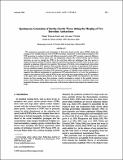Por favor, use este identificador para citar o enlazar a este item:
http://hdl.handle.net/10261/15501COMPARTIR / EXPORTAR:
 SHARE SHARE
 CORE
BASE CORE
BASE
|
|
| Visualizar otros formatos: MARC | Dublin Core | RDF | ORE | MODS | METS | DIDL | DATACITE | |

| Título: | Spontaneous generation of inertia–gravity waves during the merging of two baroclinic anticyclones |
Autor: | Pallàs-Sanz, Enric CSIC; Viúdez, Álvaro CSIC ORCID | Fecha de publicación: | ene-2008 | Editor: | American Meteorological Society Allen Press |
Citación: | Journal of Physical Oceanography 38(1): 213-234 (2008) | Resumen: | The spontaneous generation and propagation of short-scale inertia–gravity waves (IGWs) during the merging of two initially balanced (void of IGWs) baroclinic anticyclones is numerically investigated. The IGW generation is analyzed in flows with different potential vorticity (PV) anomaly, numerical diffusion, numerical resolution, vortex aspect ratio, and background rotation. The vertical velocity and its vertical derivative are used to identify the IGWs in the total flow, while the unbalanced flow (the waves) is diagnosed using the optimal PV balance approach. Spontaneous generation of IGWs occurs in all the cases, primarily as emissions of discrete wave packets. The increase of both the vortex strength and vortex extent isotropy enhances the IGW emission. Three possible indicators, or theories, of spontaneous IGW generation are considered, namely, the advection of PV, the material rate of change of the horizontal divergence, and the three-dimensional baroclinic IGW generation analogy of Lighthill sound radiation theory. It is suggested that different mechanisms for spontaneous IGW generation may be at work. One mechanism is related to the advection of PV, with the IGWs in this case having wave fronts similar to the PV isosurfaces in the upper layers, and helical patterns in the deep layers. Trapped IGWs are ubiquitous in the vortex interior and have annular wave front patterns. Another mechanism is related to the spatially coherent motion of preexisting IGWs, which eventually cooperate to produce mean flow, in particular larger-scale horizontal divergence, and therefore larger-scale vertical motion, which in turns triggers the emission of new IGWs. | Descripción: | 22 pages, 26 figures, 1 table | Versión del editor: | https://doi.org/10.1175/2007JPO3716.1 | URI: | http://hdl.handle.net/10261/15501 | DOI: | 10.1175/2007JPO3716.1 | ISSN: | 0022-3670 |
| Aparece en las colecciones: | (ICM) Artículos |
Ficheros en este ítem:
| Fichero | Descripción | Tamaño | Formato | |
|---|---|---|---|---|
| Pallas_et_al_2008.pdf | 3,46 MB | Adobe PDF |  Visualizar/Abrir |
CORE Recommender
SCOPUSTM
Citations
6
checked on 21-abr-2024
WEB OF SCIENCETM
Citations
8
checked on 23-feb-2024
Page view(s)
388
checked on 23-abr-2024
Download(s)
266
checked on 23-abr-2024
Google ScholarTM
Check
Altmetric
Altmetric
NOTA: Los ítems de Digital.CSIC están protegidos por copyright, con todos los derechos reservados, a menos que se indique lo contrario.
